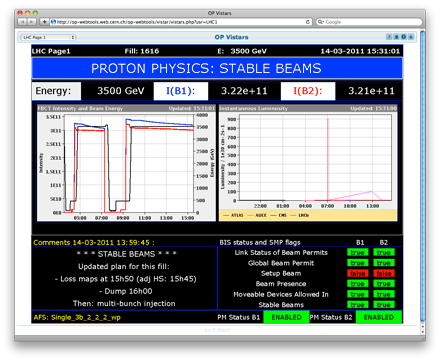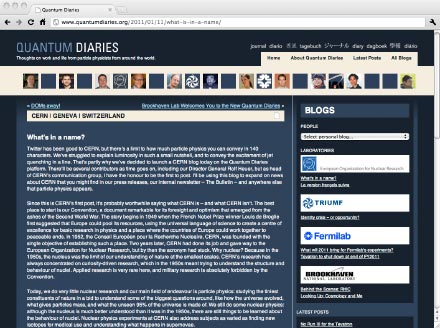25.03.2001: LHC: impressive start to 2011 run

The CERN Control Centre's optical fibre starpoint, which serves the LHC installations and the computing centre in Meyrin. CERN’s 35,000 km of optical fibres are used to synchronise the accelerators, take measurements of the beams and to send controls to the LHC.
After just a month of operation in 2011, the LHC has already achieved more than half the total number of proton-proton collisions delivered in 2010. The experiments have accumulated an integrated luminosity of 28 pb-1 this year. Integrated luminosity is a measure of the total number of proton-proton collisions measured by the experiments.
The impressive progress is the result of a rapid succession of LHC “fills” with increasing numbers of proton bunches. It indicates how quickly the LHC operators are now able to turn the machine around between successive fills, and how well LHC running has been incorporated into the overall operation of CERN’s accelerator complex.
More information
14.03.2011: First 7 TeV collisions of 2011

A screenshot of 'LHC Page One' — which displays the status of the accelerator — showing stable beams in the LHC.
Data taking has begun for the 2011 run after stable beams at an energy of 3.5 TeV were announced shortly after 6pm on 13th March. Physicists from the LHC experiments will now begin acquiring and analysing data from proton collisions, slowly building evidence for current models and seeking tantalizing clues of new physics.
Data from over 3000 billion collisions was recorded in 2010 by the CMS and ATLAS experiments.
More information
07.03.2011: Simon van der Meer 1925-2011

Simon van der Meer photographed by Volker Steger in 2008
CERN was deeply saddened to learn the news that our friend and colleague, Simon van der Meer, passed away on 4 March 2011.
More information
23 02 2011: The LHC gets
going for 2011

The LHC ready for restart. Photo: Maximilien Brice. More photos »
The LHC is taking strides towards its run for 2011. For the first time this year, following the winter shutdown, bunches of particles entered the machine from the injection chain on the evening of 19 February. Less than 4 hours later, beam circulated in both directions around the machine at the injection energy of 450 GeV, early on 20 February. The following night, beams were successfully ramped to the operational energy of 3.5 TeV. This first phase of setting-up is to re-establish running conditions before the first collisions of 2011 take place, initially at 450 GeV.
More information
31 01 11: LHC to run in 2012

Engineers working in the ATLAS experimental cavern during the LHC's planned technical stop, January 2011. Photo: Claudia Marcelloni. More photos »
CERN today announced that the LHC will run through to the end of 2012 with a short technical stop at the end of 2011. The beam energy for 2011 will be 3.5 TeV. This decision, taken by CERN management following the annual planning workshop held in Chamonix last week and a report delivered today by the laboratory’s machine advisory committee, gives the LHC’s experiments a good chance of finding new physics in the next two years, before the LHC goes into a long shutdown to prepare for higher energy running starting 2014.
More information
11 01 11: CERN launches new blog on Quantum Diaries

CERN is launching a new blog on the Quantum Diaries platform. Until now Quantum Diaries was focussed on providing a platform for individual particle physicists from around the world to post their thoughts on work and life. Today CERN and other particle physics laboratories have joined by launching official institutional blogs.
Quantum Diaries is an initiative of the Interactions collaboration, a joint communication resource from the world's physics laboratories.
Read the first post on CERN's new Quantum Diaries blog »